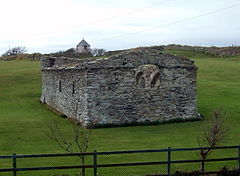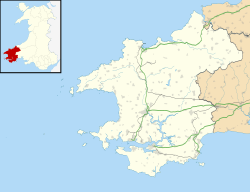
St Davids or St David's is a cathedral city in Pembrokeshire, Wales. It lies on the River Alun and is part of the community of St Davids and the Cathedral Close. It is the resting place of Saint David, Wales's patron saint, and named after him. St Davids is the United Kingdom's smallest city and urban area. St Davids was given city status in the 12th century. This does not derive automatically from criteria, but in England and Wales it was traditionally given to cathedral towns under practices laid down in the early 1540s, when Henry VIII founded dioceses. City status was lost in 1886, but restored in 1994 at the request of Queen Elizabeth II.

Ramsey Island is an island about 1 kilometre off St David's Head in Pembrokeshire on the northern side of St Brides Bay, in southwest Wales, in the community of St Davids and the Cathedral Close. It is 259 hectares in area. Ramsey means Hrafn's island.

Nevern is both a parish and a community in Pembrokeshire, Wales. The community includes the settlements of Felindre Farchog, Monington, Moylgrove and Bayvil. The small village lies in the Nevern valley near the Preseli Hills of the Pembrokeshire Coast National Park 2 miles (3 km) east of Newport on the B4582 road.

Dinas Cross is both a village, a community and a former parish in Pembrokeshire, Wales. Located between Fishguard and Newport in the Pembrokeshire Coast National Park, it is a popular holiday destination on the A487 road. The two hamlets, Cwm-yr-Eglwys and Pwllgwaelod, are in the community. The community has an elected community council and until 2022 gave its name to an electoral ward of Pembrokeshire County Council which covered the communities of Dinas Cross, Cwm Gwaun and Puncheston.
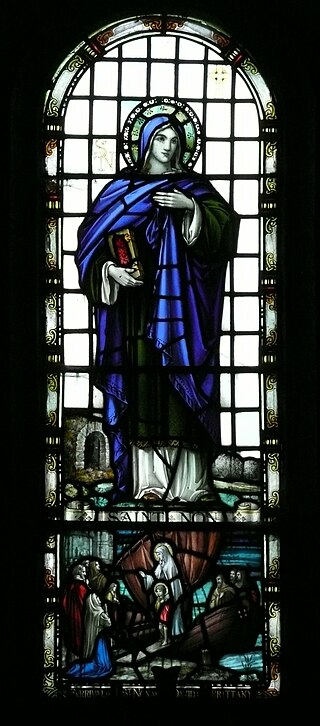
Non was, according to Christian tradition, the mother of Saint David, the patron saint of Wales.
Saint Justinian was a 6th-century hermit who lived on Ramsey Island, near St. David's, in the Welsh county of Pembrokeshire.

The Chapel of St Non is located on the coast near St David's in Pembrokeshire, West Wales. Held by tradition to mark the birthplace of St David, the ruin cannot be accurately dated but is unusual in that it is aligned north–south rather than the usual east–west. Near to the ruined chapel is a retreat, a modern chapel and a holy well. The site was protected in the 1950s and is now the responsibility of the Welsh Heritage organisation Cadw.
Nidan was a Welsh priest and, according to some sources, a bishop, in the 6th and 7th centuries. He is now commemorated as a saint. He was the confessor for the monastery headed by St Seiriol at Penmon, and established a church at what is now known as Llanidan, which are both places on the Welsh island of Anglesey. He is the patron saint of two churches in Anglesey: St Nidan's Church, Llanidan, built in the 19th century, and its medieval predecessor, the Old Church of St Nidan, Llanidan. Midmar Old Kirk in Aberdeenshire, Scotland, is also dedicated to him: Nidan is said to have helped to establish Christianity in that area as a companion of St Kentigern. St Nidan's, Llanidan, has a reliquary dating from the 14th or 16th century, which is said to house his relics.

The Old Church of St Gwenllwyfo, Llanwenllwyfo is a medieval ruined church near Dulas, in Anglesey, Wales, perhaps built in the 15th century to replace another church from which only the 12th-century font survived. Dedicated to Gwenllwyfo, a 7th-century female saint about whom nothing else is known, it was used as a chapel of ease for the church in Amlwch, about 5 miles (8 km) away. Restored in 1610 and again in the 18th and 19th centuries, it contained an oak screen and pulpit from 1610.
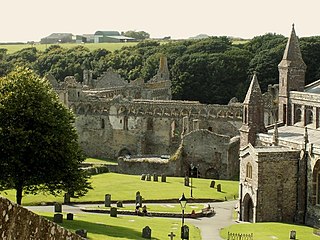
St Davids Bishops Palace is a ruined medieval palace located adjacent to St Davids Cathedral in the city of St Davids, Pembrokeshire, one of the most important ecclesiastical sites in Wales. The site dates back to the 6th century, although the building that stands today dates largely from the late 13th and 14th centuries.

This is a list of Grade I-listed buildings in the county of Pembrokeshire, Wales.

St Justinian is a coastal location of indeterminate area in the extreme northwest of Pembrokeshire, Wales, in the community of St Davids and the Cathedral Close.

Rudbaxton is a village, parish and a local government community in the county of Pembrokeshire, Wales. It is 81 miles (130 km) from Cardiff and 208 miles (335 km) from London.

Capel Colman is a parish in northeast Pembrokeshire, Wales, in the community of Boncath. Formerly in the Hundred of Cilgerran, Capel Colman is a small, rural parish of some 750 acres (300 ha) surrounded by the larger parishes of Cilgerran, Manordeifi, Clydau, Penrydd and Llanfihangel Penbedw. The parish is in the Manordeifi group in the Church in Wales Diocese of St David's.
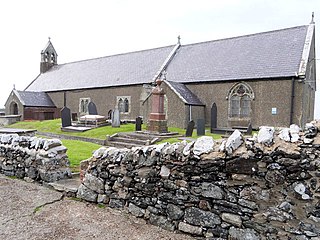
St Peter's Church is a medieval church situated on the western side of the village of Newborough, Anglesey, Wales. The building dates from the early 14th century and underwent restorations in the 19th century. It was designated a Grade II*-listed building on 30 January 1968. It has an interesting history and is the longest church on Anglesey.

The Church of Saint John the Baptist is a small Greek Orthodox church in the Muristan area of the Christian Quarter of Jerusalem. In its current form, most of the above-ground church dates to the 11th century, and the crypt to the Late Roman or Byzantine period.

Llanstinan is a rural parish in the community of Scleddau, north Pembrokeshire, Wales, 3 miles (4.8 km) south of Fishguard.

St Michael's Church is a Grade I listed building and parish church in the community and parish of Rudbaxton in Pembrokeshire, Wales. The building dates from the 15th century, and has a 12th-century font. It was listed on 1 March 1963 as a fine example of a substantial mediaeval double-nave church with important memorials.

The Church of St Nicholas & St John, formerly the Priory Church of St Nicholas, is the parish church of Monkton, a village on the south bank of the Milford Haven Waterway, in south Pembrokeshire, Wales. The church's medieval origins link it to Monkton Priory, founded in the 11th century. It is a Grade I listed building.

St Elidyr's Church, is a Grade I listed building in south Pembrokeshire, Wales. The church is in the small village of Carew Cheriton in the southwest of the parish of Stackpole Elidor, on the Stackpole Estate in the community of Stackpole and Castlemartin.
